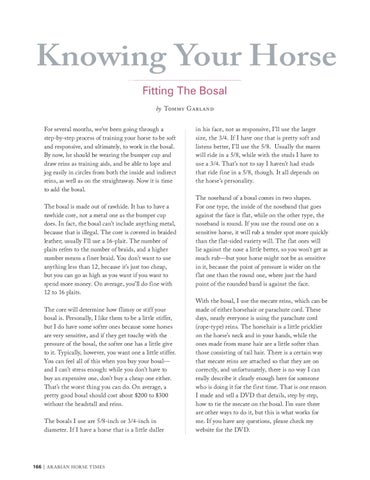Knowing Your Horse Fitting The Bosal by Tommy Garland For several months, we’ve been going through a step-by-step process of training your horse to be soft and responsive, and ultimately, to work in the bosal. By now, he should be wearing the bumper cup and draw reins as training aids, and be able to lope and jog easily in circles from both the inside and indirect reins, as well as on the straightaway. Now it is time to add the bosal. The bosal is made out of rawhide. It has to have a rawhide core, not a metal one as the bumper cup does. In fact, the bosal can’t include anything metal, because that is illegal. The core is covered in braided leather; usually I’ll use a 16-plait. The number of plaits refers to the number of braids, and a higher number means a finer braid. You don’t want to use anything less than 12, because it’s just too cheap, but you can go as high as you want if you want to spend more money. On average, you’ll do fine with 12 to 16 plaits. The core will determine how flimsy or stiff your bosal is. Personally, I like them to be a little stiffer, but I do have some softer ones because some horses are very sensitive, and if they get touchy with the pressure of the bosal, the softer one has a little give to it. Typically, however, you want one a little stiffer. You can feel all of this when you buy your bosal— and I can’t stress enough: while you don’t have to buy an expensive one, don’t buy a cheap one either. That’s the worst thing you can do. On average, a pretty good bosal should cost about $200 to $300 without the headstall and reins. The bosals I use are 5/8-inch or 3/4-inch in diameter. If I have a horse that is a little duller
166 | AR ABIAN HORSE TIMES
in his face, not as responsive, I’ll use the larger size, the 3/4. If I have one that is pretty soft and listens better, I’ll use the 5/8. Usually the mares will ride in a 5/8, while with the studs I have to use a 3/4. That’s not to say I haven’t had studs that ride fine in a 5/8, though. It all depends on the horse’s personality. The noseband of a bosal comes in two shapes. For one type, the inside of the noseband that goes against the face is flat, while on the other type, the noseband is round. If you use the round one on a sensitive horse, it will rub a tender spot more quickly than the flat-sided variety will. The flat ones will lie against the nose a little better, so you won’t get as much rub—but your horse might not be as sensitive in it, because the point of pressure is wider on the flat one than the round one, where just the hard point of the rounded band is against the face. With the bosal, I use the mecate reins, which can be made of either horsehair or parachute cord. These days, nearly everyone is using the parachute cord (rope-type) reins. The horsehair is a little pricklier on the horse’s neck and in your hands, while the ones made from mane hair are a little softer than those consisting of tail hair. There is a certain way that mecate reins are attached so that they are on correctly, and unfortunately, there is no way I can really describe it clearly enough here for someone who is doing it for the first time. That is one reason I made and sell a DVD that details, step by step, how to tie the mecate on the bosal. I’m sure there are other ways to do it, but this is what works for me. If you have any questions, please check my website for the DVD.
